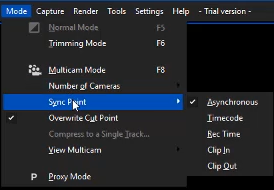Tutorial: How to Edit and Repurpose Your Multicam Live Content with EDIUS Pro 8 on Wirecast Gear
迈克·唐尼 demonstrates how to post-produce your multicam content quickly and efficiently using 草谷EDIUS Pro 8 on Wirecast Gear.
在本教程中, I’ll show you how to post-produce your live content quickly and efficiently using Grass Valley EDIUS on Wirecast Gear. 我在和 广播齿轮110 (下面的图1), which comes with four HDMI inputs and allows you to ingest, live-switch, and stream four HDMI sources simultaneously. It also records the streams, which means you can manipulate them afterwards as well. Here we’re going to talk about some of the reasons why you need post-production software on this piece of equipment, 比如剪掉预演, or repurposing the content that you just got through streaming to make shorter videos for social media, or creating highlight reels from your live streams. That’s what I’m going to be showing you in EDIUS Pro 8, which not only does all of this, but does it extremely well and very, very quickly.

图1. 广播齿轮110
开始在EDIUS Pro 8
I’ve installed EDIUS directly on the Wirecast Gear, which is a very powerful computer and can handle anything that I can throw at it while editing. To start EDIUS Pro 8, I double-click on the EDIUS icon. When it first comes up, I select New Project. I have some presets available for my Project Settings, all high-definition (下面的图2), but you can have standard definition or anything that you would like. Next, I pick a resolution, and create a name for my project. After I do that, I just select OK to open the main EDIUS window.

图2. The EDIUS Pro 8 Project Settings dialog
The first thing I’m going to do is bring in my footage. EDIUS opens with my first sequence in the Bin window. 我可以有多个序列, but for the sake of this demonstration we’re just going to leave it as one. 导入素材, I can right-click inside the bin and select Add File, 或者我可以按Ctrl-O, or I can just double-click with the left mouse button and it opens my browser so I can locate my footage. 如图所示 图3(下面), I’m just going to grab Camera 1 and Camera 2 that I recorded in Wirecast and select Open. Once these are imported, I’m ready to use them.

图3. Importing the footage recorded in Wirecast
接下来选择模式. In the Mode pull-down menu shown in 图4 (below), 你可以看到Multicam模式, 摄像机数量, 同步点, 及摄影机数目. Because I’m working with only two sources in this demo, I’ll select Two Plus Master. I don’t have a way to sync these sources automatically, but if you have cameras that have timecode and you’re using SDI inputs (available on the 无线广播Gear 210 or 220), then you’d be able to take any number of files and be able to line them up automatically with timecode and start editing immediately.

图4. 选择编辑设置
Working with this timecode feature in EDIUS has real benefits for live event producers. If you have cameras that have free-run timecode, 当他们不录音的时候, they’re continuing with the timecode going. If you have one camera that’s going around 拍摄的东西, 停止, 拍摄的东西, 停止, when you bring in all those clips from that camera, 如果你用的是时间码, it will place them down onto one video track and space them correctly to where they are in the exact spots that they need to be. 这真是令人印象深刻.
相关文章
Here's a look inside EDIUS Pro 7's MultiCam Mode, exploring how it streamlines editing up to 16 cameras, and leaves plenty of room for adjustments and tweaks after you make your initial cuts.
One of the great things about Grass Valley EDIUS 7 is its ability to take footage in multiple codecs and frame rates, 把它们放在同一时间线上, 并且实时编辑和播放它们. 在本教程中, we'll explore how to leverage this feature in your projects.